In its prime, Magdala was a prominent city along the trade routes surrounding the Galilee.
This is evidenced by the extensive and well-designed marketplace unearthed by archaeologists.
A central paved street is flanked on its eastern side with shops that would likely have sold everything from pottery to woven goods to fresh produce.
One of the most impressive discoveries in the marketplace was the technologically advanced plumbing system which connected the shops with individual access to fresh groundwater.
This system, which would have been a marvel 2,000 years ago, is even more astonishing because it still functions today.

Magdala Stone
Perhaps the most exciting discovery at Magdala thus far, however, is the Magdala Stone, which has produced a lot of excitement among the archaeologists working at the site. According to our tour guide, the stone, which was uncovered in the Migdal Synagogue during 2009 excavations, may hold clues that will help scholars establish a better picture of first century Judaism. Scholars believe that the stone was carved before the Romans destroyed the Second Temple in 70 CE. In 2017, the stone was displayed in Rome in Menorah: Worship, History, Legend, an exhibition jointly sponsored by the Vatican and the Jewish Museum of Rome.
The front of the stone depicts the oldest carved image of the Second Temple’s seven-branched menorah ever found, and the long sides of the stone depict a building with pillared archways. The rest of the stone is covered in decorative symbols relating to the structure of the Temple and ceremonial Jewish objects.
Prosperous city
Magdala was clearly an influential and prosperous city in its time, as evidenced by the elaborately decorated buildings which have been found there. Several buildings identified as mansions, most likely the homes of wealthy merchants, are located along a street south of the synagogue. These mansions were paved with colorful and intricate mosaic floors, which can still be seen today.
Another impressive feature of the city are the four mikvaot ritual baths, the earliest ever discovered in the country to use groundwater. The sophisticated plumbing of these mikvaot is proof that Magdala was at the forefront of regional commerce and culture in the first century.
The archaeological park at the site of the hotel is open every day from 8:00 a.m. to 6:00 p.m. for visitors – but as a guest you can walk around the reconstructed areas at all hours of the day, or join the daily guided tour.
